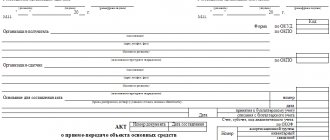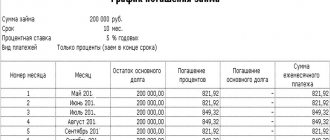Legal basis
The parties entered into a loan agreement.
Its maturity date is coming. But the borrower does not have available funds to repay his debt. But there is property that he would like to transfer to pay off his debt. And if the lender is not against such “repayment,” then the parties draw up an agreement on compensation (Article 409 of the Civil Code of the Russian Federation). In this case, the borrower’s obligation to repay the loan ceases, but a new obligation appears - to transfer property. Let us recall that until June 1, 2015, compensation was provided not only by transfer of property, but also, in particular, in the form of performing work (rendering services), since the previous version of Article 409 of the Civil Code of the Russian Federation contained an open list of methods for providing compensation.
It is important to know that the obligation is considered extinguished at the moment the compensation is provided, and not at the moment the agreement on it is signed. This means that on the date of concluding the agreement on the provision of compensation, the borrower’s obligation does not terminate. To terminate the obligation, the actual provision of compensation, that is, the transfer of property, is necessary. Therefore, if the loan is interest-bearing, then interest accrues until the borrower transfers the property. And if real estate is provided as compensation, then the compensation agreement is considered executed only after state registration of the transfer of ownership of the real estate to the creditor. This conclusion follows from the Resolution of the Presidium of the Supreme Arbitration Court of the Russian Federation dated June 17, 2014 No. 2826/14 in case No. A57-2430/2011.
And one more important point. Within the meaning of Article 409 of the Civil Code of the Russian Federation, unless otherwise follows from the compensation agreement, with the provision of compensation all obligations under the contract are terminated, including the obligation to pay a penalty (clause 3 of the Information Letter of the Presidium of the Supreme Arbitration Court of the Russian Federation dated December 21, 2005 No. 102). This means that if the loan was interest-bearing, then with the compensation agreement all obligations are repaid, including the payment of interest. Unless, of course, otherwise provided in the agreement. Therefore, if the lender wants to receive his interest in cash, and the body of the loan itself is ready to receive “in kind,” then the corresponding procedure must be specified in the agreement. Otherwise, with the provision of compensation, the entire debt will be repaid, that is, the loan itself and the interest on it.
The value of the property transferred as compensation does not have to be equivalent to the debt under the terminated obligation (clause 4 of the Information Letter of the Presidium of the Supreme Arbitration Court of the Russian Federation dated December 21, 2005 No. 102, Resolution of the Federal Antimonopoly Service of the North-Western District dated March 16, 2012 in case No. A56- 30457/2009). Therefore, the borrower can set the value of the transferred property either higher or lower than his debt. In this case, the parties must decide whether the transfer of “unequal” property will repay the loan obligation in full? Or will it “cover” the debt only partially (in terms of the value of the transferred property)? The fact is that if this point is not reflected in the compensation agreement, then by default it is considered that the obligation is terminated completely (clause 4 of the Information Letter of the Presidium of the Supreme Arbitration Court of the Russian Federation dated December 21, 2005 No. 102).
Civil relations
According to Article 409 of the Civil Code of the Russian Federation, by agreement of the parties, the obligation can be terminated by providing compensation in exchange for execution (payment of money, transfer of property, etc.). The amount, terms and procedure for providing compensation are established by the parties to the agreement. To do this, the parties must enter into a compensation agreement . The transfer of property (car) must be confirmed by a transfer and acceptance certificate .
In IAS “1C: Consulting. Standard" for more details, see the analytics on the topic "Indemnity Agreement", as well as the "Sample Documents" tab for the "Indemnity" certificate in the "Termination of Obligations" section of the "General Provisions on Obligations" subsection of the "Obligations" section. Treaties".
Transferred the property? Add VAT!
The transfer of property (whether goods, products or fixed assets) as compensation is recognized as a sale for VAT purposes. Indeed, in accordance with paragraph 1 of Article 39 of the Tax Code of the Russian Federation, the sale of goods by an organization or an individual entrepreneur is recognized as the transfer on a reimbursable basis, of the right of ownership of goods to another person.
In this case, when transferring property, a transfer of ownership occurs, which means there is a sale. And the sale of goods, including under an agreement on the provision of compensation, is subject to VAT (subclause 1, clause 1, article 146 of the Tax Code of the Russian Federation). Unless, of course, the borrower applies the usual taxation system and is not exempt from VAT under Article 145 of the Tax Code of the Russian Federation. The tax base is defined as the value of the transferred property, calculated on the basis of prices determined in accordance with Article 105.3 of the Tax Code of the Russian Federation, and without including tax in them (clause 1 of Article 154 of the Tax Code of the Russian Federation). According to paragraph 1 of Article 105.3 of the Tax Code of the Russian Federation, prices used in transactions in which the parties are persons who are not recognized as interdependent are recognized as market prices. In fact, this means that the value of the property that the parties agreed upon, excluding VAT, should be included in the VAT tax base. By adding VAT on top (multiplying by 118%), we get the value of the property including VAT. It is this value that should be specified in the compensation agreement.
Since the transfer of property as compensation is a VAT-taxable operation, an invoice must be issued along with the transfer act. It should be registered in the sales ledger and then included in the VAT return.
Income tax
For an operation related to the provision of compensation to the lender, the borrower receives income from the sale (clause 1 of Article 249 of the Tax Code of the Russian Federation). Sales proceeds are determined based on all receipts associated with payments for goods sold (clause 2 of Article 249 of the Tax Code of the Russian Federation). In this case, income included in taxable profit will be formed based on the value of the property established in the compensation agreement (minus VAT). At the same time, the value of the property at which it was registered can be included in expenses (clause 1 of Article 268 of the Tax Code of the Russian Federation).
Reflected in accounting
When transferring property to a counterparty as compensation, the organization, in the generally established manner, reflects the disposal of property using account 90 “Sales” or account 91 “Other income and expenses.”
Income from the transfer of property is recognized in the amount of the value of the property reflected in the agreement. The cost of the transferred property is included in the cost of sales or other expenses (if property other than products or goods is transferred). For clarity, we will consider the reflection in accounting of transactions for the transfer of compensation using a practical example.
Example:
Financial House LLC issued Skazka LLC an interest-bearing loan in the amount of 110,000 rubles. The parties entered into a compensation agreement. As compensation, equipment is transferred at a cost of 118,000 rubles. (including VAT – 18,000 rubles). The residual value of the equipment was 60,000 rubles. At the time of transfer of property, the interest debt amounted to 8,000 rubles. and the total debt under the loan agreement is 118,000 rubles, which corresponds to the cost of the transferred equipment, including VAT.
Debit 62 (76) Credit 91
— 118,000 rub. – equipment was transferred as compensation;
Debit 91 Credit 01
— 60,000 rub. – reflects the residual value of the property;
Debit 91 Credit 68
— 18,000 rub. – VAT is charged on the value of the transferred compensation;
Debit 66 Credit 62 (76)
— 118,000 rub. – reflects the repayment of debt on a loan obligation.
Accounting
When transferring a car as compensation, the organization recognizes in accounting other income from its disposal (clauses 7, 16 of the Accounting Regulations “Income of the Organization” PBU 9/99, approved by order of the Ministry of Finance of Russia dated May 6, 1999 No. 32n). In this case, the amount of income is equal to the amount of the repaid loan debt (clause 10.1, paragraph 1, clause 6.3 of PBU 9/99). Repayment of debt in this case is reflected in accounting by an entry in the debit of account 66 (67) and the credit of account 91 “Other income and expenses” , subaccount 91-1 “Other income” (Instructions for using the Chart of Accounts for accounting financial and economic activities of organizations, approved by order of the Ministry of Finance of Russia dated October 31, 2000 No. 94n).
Simultaneously with the recognition of other income, the organization recognizes other expenses in the form of the residual value of the transferred car (clause 11, clause 14.1, clause 16, clause 19 of the Accounting Regulations “Organization Expenses” PBU 10/99, approved by order of the Ministry of Finance of Russia dated 05/06/1999 No. 33n, clause 30, clause 31 of the Accounting Regulations “Accounting for fixed assets” PBU 6/01, approved by order of the Ministry of Finance of Russia dated 03/30/2001 No. 26n).
To account for the disposal of fixed assets, a separate subaccount “Disposal of fixed assets” can be opened to account 01 “Fixed Assets,” which records the initial cost of fixed assets. The initial cost of the asset is transferred to the debit of this subaccount of account 01, and to the credit - the amount of accumulated depreciation listed on account 02 “Depreciation of fixed assets” (Instructions for using the Chart of Accounts). Other expenses are reflected in account 91 “Other income and expenses”, subaccount 91-2 “Other expenses” (Instructions for using the Chart of Accounts).
In this case, an entry is made to the debit of account 91, subaccount 91-2 “Other expenses” and to the credit of account 01 subaccount “Retirement of fixed assets”.
Unequal compensation
It may happen that the compensation agreement will indicate the value of the transferred property, which is less or more than the debt under the original agreement, but will not stipulate in what part the debt is repaid.
Or it will be stated that the transfer of such property completely terminates all obligations under the loan agreement. In such cases, tax risks are likely. If the value of the property exceeds the terminated obligation, then the risks arise with the receiving party (the lender). Officials believe that in this situation the organization must reflect non-operating income on which it is necessary to pay income tax. This conclusion can be seen, for example, in Letters of the Ministry of Finance of the Russian Federation dated February 3, 2010 No. 03-03-06/1/42, Federal Tax Service of Russia for Moscow dated December 5, 2007 No. 19-11/116142. By taxing this difference to income tax, the company will eliminate tax risks.
At the same time, officials note that for a borrower who transferred property worth more than the amount of his debt, the resulting difference cannot be attributed to a decrease in taxable profit.
In the opposite situation (the value of the property is less than the amount of the terminating obligation), risks arise with the transferring party, that is, with the borrower. The Federal Tax Service will consider that it has generated non-operating income in the amount of the excess. At the same time, the loss that the other party (the lender) receives, according to officials, cannot be accepted for tax purposes (Letter of the Federal Tax Service of Russia for Moscow dated December 5, 2007 No. 19-11/116142).
Taking all this into account, it is better for the parties not to resort to “unequal exchange”. Or the value of the property transferred as compensation should be adjusted to the amount of the debt being repaid. This will not be a violation, because the prices used in transactions, the parties to which are persons who are not recognized as interdependent, are recognized as market prices (clause 1 of Article 105.3 of the Tax Code of the Russian Federation). In other words, the price that the parties determined in the agreement will be the market price.
Loan repayment with property: tax consequences
Legal nuances
According to Article 409 of the Civil Code, by agreement of the parties, an obligation, including a loan, can be terminated by providing compensation in return for execution.
In other words, instead of money, the borrower can transfer goods, fixed assets or other property to the lender. In this case, the amount, terms and procedure for providing compensation are established by the parties. Within the meaning of Article 409 of the Civil Code of the Russian Federation, unless otherwise follows from the compensation agreement, with the provision of compensation, all obligations under the contract are terminated, including the obligation to pay a penalty (clause 3 of the information letter of the Presidium of the Supreme Arbitration Court of the Russian Federation dated December 21, 2005 No. 102).
The compensation value specified in the agreement may be higher or lower than the obligation being terminated. In such a situation, it is extremely important to clearly indicate in the agreement whether the obligation is repaid in full or in part (and in what part). In the absence of this information, the courts proceed from the fact that the obligation is terminated completely (clause 4 of the information letter of the Presidium of the Supreme Arbitration Court of the Russian Federation dated December 21, 2005 No. 102).
When indicating in the compensation agreement the value of the transferred property, it is not at all necessary to focus on the value at which the transferred property was listed in the borrower’s books. It may well be that the residual value of the transferred fixed asset is less than the value specified in the agreement, and the parties decide that the transfer of this property completely terminates the obligation. The opposite option is also possible - the residual value is higher than the value specified in the compensation agreement.
However, if the value of the property specified in the compensation differs from the amount of the terminated obligation, the parties face certain tax risks. We'll talk about them a little later.
Upon transmission, an implementation occurs
When repaying a loan debt by transferring property, it should be understood that such transfer is regarded as a sale. Indeed, according to paragraph 1 of Article 39 of the Tax Code, the sale of goods by an organization or individual entrepreneur is recognized as the transfer of ownership of goods to another person on a compensated basis. In this case, when transferring property, a transfer of ownership occurs, which means there is a sale. And sales, as you know, are subject to taxes. If the borrower works for OSNO, then the obligation to pay VAT and income tax arises. Accordingly, when transferring the compensation, the borrower will have to draw up an invoice.
Here you should determine what amount should be included in the tax base for taxes. So, the tax base for VAT on sales is determined based on market prices, that is, the price specified by the parties to the transaction (clause 1 of Article 154 of the Tax Code of the Russian Federation, clause 1 of Article 40 of the Tax Code of the Russian Federation), without including tax. This means that when calculating VAT, you need to focus on the value of the property specified in the compensation agreement. This opinion is also supported by officials (letter of the Ministry of Finance of Russia dated July 27, 2005 No. 03-11-04/2/34).
Example 1
The debt under the loan agreement, taking into account accrued interest, amounted to 630,000 rubles. The borrower transfers a car, the cost of which is indicated in the agreement in the amount of 540,000 rubles, as payment for the repayable obligation. (VAT included). The compensation agreement provides for full repayment of the obligation.
When transferring a car as compensation, the borrower has a sale subject to VAT. The tax base for VAT will be 457,627 rubles. (540,000 rub. – (540,000 rub. x 18/118%)). The tax amount is RUB 82,373. (RUB 457,627 x 18%).
Also, the borrower will have to reflect the income in tax accounting, that is, for the purpose of calculating income tax. According to paragraph 1 of Article 249 of the Tax Code of the Russian Federation, sales income is revenue from the sale of goods. And sales revenue is determined based on all receipts associated with payments for goods sold (clause 2 of Article 249 of the Tax Code of the Russian Federation). In this case, the income included in taxable profit will be 457,627 rubles. (540,000 rubles – 82,373 rubles (this is the amount of VAT)). But at the same time, the borrower has the right to include the residual value of the car as an expense item (subclause 1, clause 1, article 268 of the Tax Code of the Russian Federation).
The party that received the compensation (the lender) will be able to deduct the amount of VAT included in the cost of the compensation based on the received invoice.
Compensation to “cover” the advance
It is worth remembering that with the method of terminating the obligation described above, the parties may face tax risks. There is a high probability that the tax authorities will regard the loan received as cover for an advance payment for the upcoming supply of goods. Then, naturally, they will try to collect tax, penalties and fines from the borrower for not paying VAT on the advance payment at the time. It should be noted that some organizations actually use such a scheme to avoid charging VAT on advances received.
To minimize risks, you should not resort to this method of repaying the loan too often. An additional argument in favor of the taxpayer will be the fact that the lender, who agreed to this method of repaying the obligation, was not previously (and subsequently became) the buyer of the borrower company. If this condition is met, it will be difficult for the tax inspectorate to prove the existence of the scheme.
The situation under consideration is fraught with other risks. Thus, the FAS of the Central District considered a similar situation, however, it was not about compensation, but about novation (with novation, the original obligation that existed between the parties is replaced by another obligation, providing for a different subject or a different method of fulfillment). In this case, the judges qualified the amount of the loan novated into the supply agreement as an advance payment. Moreover, the moment of determining the tax base in the case under consideration, the arbitrators recognized not even the date of concluding the novation agreement, but the date of receipt of borrowed funds (resolution of the Federal Antimonopoly Service of the Central District dated January 22, 2009 in case No. A64-7270/07-13). But, perhaps, if we were talking about compensation, the situation would have been resolved in court in favor of the taxpayer.
If we talk about the explanations of officials, they inspire some optimism. For example, previously officials took the following position. When concluding an agreement on the novation of a borrowed obligation into an obligation to supply goods, the borrowed funds received are considered as advance payments towards the upcoming supply of goods, and are subject to inclusion in the VAT tax base in the tax period in which they were received (letter from the Ministry of Finance of Russia dated 07.09 .05 No. 03-04-11/221).
Subsequently, the Federal Tax Service, in coordination with the Ministry of Finance, issued a letter dated November 28, 2008 No. ШС-6-3/ [email protected] In it, officials noted that when an agreement is concluded between the borrower and the lender on the repayment by the borrower of its obligations under the loan agreement by shipping goods to the lender, funds received by the borrower in accordance with the loan agreement should be considered on the date of conclusion of the specified agreement as an advance payment for the upcoming delivery of goods. That is, now the official position of the tax and financial departments is that the obligation to calculate VAT arises not at the moment when the money was received as a loan, but at the moment when the parties entered into an agreement on compensation or novation. It’s good if the drawing up of this agreement and the transfer of property takes place in the same quarter. If the transfer of property occurs in another quarter, then the borrower faces new tax risks.
But here you can put forward the following argument. Until the compensation is granted, the obligation to repay the loan actually continues to exist. The Presidium of the Supreme Arbitration Court of the Russian Federation drew attention to this in paragraph 1 of the information No. 102 mentioned above, indicating that the obligation (to repay the loan) terminates from the moment the compensation is provided in return for performance, and not from the moment the parties reach an agreement on compensation. Therefore, loan debt cannot be considered an advance payment. However, this point of view will most likely have to be defended in court.
Unequal "exchange"
The following tax risks arise in a situation where the value of the property specified in the agreement does not coincide with the amount of the loan obligation being repaid, and in this case the obligation is terminated completely.
If the value of the property exceeds the terminated obligation, then the risks arise with the receiving party (the lender). Officials believe that in this situation the organization must reflect non-operating income on which it is necessary to pay income tax. This conclusion can be seen, for example, in letters from the Ministry of Finance of Russia dated 02/03/10 No. 03-03-06/1/42, Federal Tax Service of Russia for Moscow dated 12/05/07 No. 19-11/116142.
In the opposite situation (the value of the property is less than the amount of the terminating obligation), risks arise with the transferring party, that is, with the borrower. Inspectors may consider that he has generated non-operating income in the amount of the excess. At the same time, the loss that the other party (the lender) receives, according to officials, cannot be taken into account for tax purposes. This is precisely the picture observed in the above example, when a car worth less than the amount of the obligation is transferred to terminate a loan obligation.
Example 2
Let's use the conditions of example 1. To avoid tax risks, the borrower must reflect non-operating income in the amount of 90,000 rubles. (630,000 – 540,000). And the lender has a loss in the amount of 90,000 rubles. will not be taken into account for tax purposes.
Thus, to minimize these risks, when setting the compensation price, it is best to focus on the amount of the terminated obligation. That is, draw up an agreement so that it follows from it that the parties agree on an equivalent “exchange”.
However, if the amount specified in the agreement differs significantly from the value of the property according to the accounting data of the transferring party, then the tax authorities may make claims against the receiving party. Such claims, in particular, were considered in the resolution of the Federal Antimonopoly Service of the North Caucasus District dated September 24, 2009 No. A32-14927/2008-51/113. In this dispute, the residual value of the transferred object was several times greater than the amount of the repaid obligation, and therefore the inspectorate assessed additional income tax on the company that received the compensation. The tax authorities considered that the excess cost was considered to be received free of charge. But the courts did not agree with this, since a gratuitous agreement is an agreement under which one party undertakes to provide something to the other party without receiving payment or other consideration from it. But in the dispute under consideration, the property was not transferred free of charge.
In addition, in addition to income tax, the inspectorate also assessed property tax, considering that the organization that received the compensation should have included the residual value of the property (formed, by the way, by the transferring party) in the property tax base. But the court also rejected this conclusion.







